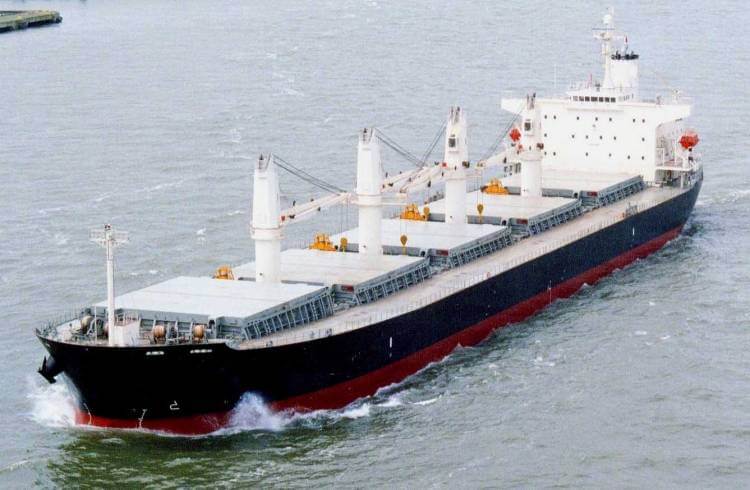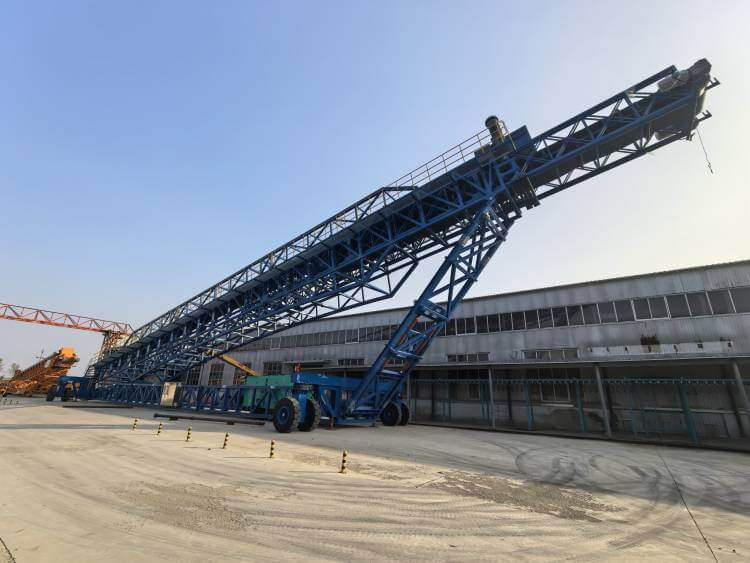Handysize and Handymax vessels are among the most commonly used ship types in ports today, primarily transporting bulk commodities such as coal (coal, coke, biomass fuel), minerals (iron ore, bauxite, phosphate rock), grains (wheat, corn, soybeans, rice, feed), and industrial raw materials (cement, clinker, fertilizer, sulfur).
Handysize vessels are approximately 120-170 meters in length, with a deadweight tonnage typically ranging from 10,000 to 40,000 tons, making them suitable for smaller ports and inland waterways. Handymax vessels are around 170-200 meters long, with a deadweight tonnage of about 40,000 to 60,000 tons, often equipped with onboard cranes, making them ideal for larger ports. Since these vessels primarily handle bulk commodities, various loading and unloading methods are required to enhance operational efficiency and accommodate different port conditions.

Ship Loader Requirements
- Loading Efficiency: For large bulk carriers or multiple small Handysize vessels, minimizing port stay time is crucial. Additionally, due to the physical characteristics of some bulk materials, ship loaders need to be capable of rapid conveying and precise positioning to reduce loading time and improve port turnover efficiency.
- Adaptability to Various Materials: Ship loaders must handle multiple material types rather than a single commodity. Therefore, the equipment should be compatible with minerals, grains, coal, and other materials while featuring excellent corrosion resistance, dust prevention, spill control, and optional functional expansions.
- High Flexibility: Bulk ship loaders must be able to rotate and extend to accommodate different cargo hold layouts. Additionally, they need to switch between multiple loading positions efficiently when servicing several vessels.
- Environmental Requirements: Many ports impose strict dust emission regulations, necessitating ship loaders equipped with dust suppression systems to minimize pollution and comply with environmental standards.
Working Principle and Advantages of Zoomry Radial Mobile Ship Loader
Rotation and Extension Functions to Improve Loading Efficiency
The core feature of the radial mobile ship loader is its ability to rotate and extend, making it highly adaptable to different vessel types and loading needs. It can rotate left and right around a fixed point (typically within a +/-90° range), ensuring precise material placement in the cargo hold and reducing the need to reposition the vessel or the ship loader. The extendable boom allows the discharge point to be adjusted according to the hold layout, ensuring even distribution of materials. Additionally, the mobile ship loader from Zoomry is equipped with a height adjustment system to accommodate vessels with varying draft depths, further enhancing adaptability and operational efficiency.
| OPERATING DIMENSIONS | ZRSL-46(m) | ZRSL-52(m) | ZRSL-58(m) | |
| Conveyor Length | A | 46 | 52 | 58 |
| Highest Extended Discharge Height | B | 16.9 | 19.1 | 21.1 |
| Lowest Extended Discharge Height | C | 4.6 | 4.9 | 5.9 |
| Highest Retracted Discharge Height | D | 8.9 | 11.8 | 12.8 |
| Lowest Retracted Discharge Height | E | 4 | 4.6 | 4.7 |
| Anchor Pivot to Center of Axle | F | 20.2 | 23.7 | 24.9 |
| Anchor Pivot to Discharge | G | 42.2 | 49 | 54.6 |
| Feed Height | H | 3.5 | 3.6 | 3.8 |
| Operating Width | 9.8 | 9.8 | 10 |
| Operating Dimensions | ZRSL-46(m) | ZRSL-52(m) | ZRSL-58(m) | |
| Undercarriage Length | A | 21 | 24.8 | 26.1 |
| Clearance (Raised) | B | 14.5 | 16.7 | 18.6 |
| Clearance (Lowered) | C | 4.6 | 4.9 | 5.9 |
| Stinger Conveyor Extension Distance | D | 18 | 19 | 24 |
| Max Height of Main Conveyor | E | 7.5 | 9.5 | 10.1 |
| Operating Dimensions | ZRSL-46(m) | ZRSL-52(m) | ZRSL-58(m) | |
| Maximum radial travel distance of extended conveyor at 90°Arc | A | 62.4 | 68.6 | 76.7 |
| Distance from rear of conveyor to edge of jetty | B | 29.8 | 36.6 | 39.4 |
| Distance from rear of conveyor to discharge point | C | 44 | 50 | 56 |
| Minimum radial travel distance of retracted conveyor at 90°Arc | D | 28 | 33 | 34 |
| Stinger conveyor extension distance | E | 18 | 19 | 24 |
| Total radial angle | 90° | 90° | 90° |
Adaptation to Different Vessel Types and Reduced Material Loss
Traditional loading methods, such as grab buckets or belt conveyors, often result in significant material losses due to the characteristics of bulk materials. This is especially true for highly dispersible or free-flowing commodities like coal, minerals, and grains, where material spillage and dust emissions can lead to economic losses and environmental pollution. Zoomry radial mobile ship loader minimizes material loss through precision conveying, utilizing rotational and telescopic technology to ensure accurate material placement. The flow control system adjusts conveyor speed based on material properties, ensuring steady loading and preventing excessive discharge or overflow, thus improving operational safety. The intelligent control system enables remote real-time monitoring of cargo hold loading status, automatically adjusting the conveyor angle to ensure even distribution. By reducing material losses and optimizing the loading process, overall handling efficiency is significantly improved.
Please contact us using the info below if you have any questions about Radial Mobile Ship Loader for Handysize and Handymax Vessels
- Zoomry official website
- +86 131-6401-6717
- oversea@zoomry.cn
Eco-Friendly Design to Reduce Dust Pollution
During coal and mineral loading operations, dust pollution not only harms the surrounding environment but also poses health risks to workers. The radial mobile ship loader incorporates multiple eco-friendly designs to effectively reduce dust emissions and improve operational safety. The enclosed conveying system, featuring a sealed belt conveyor structure, prevents dust from escaping during transportation. The dust suppression and spray system utilizes water misting devices or bag filter systems to minimize airborne dust, creating a cleaner working environment. Additionally, the flexible hose discharge port ensures slow material flow into the cargo hold, significantly reducing dust dispersion caused by large drop heights. These optimizations enhance port operations while ensuring compliance with environmental regulations, achieving green and efficient loading processes.

Port and Terminal Case Study
Port of Newcastle is one of the most significant coal export terminals in Australia and worldwide, handling over 150 million tons of coal annually, primarily for Asian markets. As global environmental standards tighten and higher demands arise for coal loading efficiency and material loss control, Port of Newcastle decided to introduce high-performance radial mobile ship loaders to enhance operations and minimize dust emissions.
By utilizing a rotating and telescopic conveying system, the mobile ship loader can quickly align with different vessel cargo holds, ensuring precise and efficient loading. Compared to traditional grab buckets or fixed belt conveyors, the radial mobile ship loader increased loading efficiency by 30%, reducing vessel berthing time and associated costs.
Additionally, Zoomry’s mobile ship loader is equipped with an intelligent control system that monitors conveyor flow rates and cargo hold filling levels in real-time, automatically adjusting the discharge angle to ensure even loading. Since its deployment, the system has helped Port of Newcastle reduce annual coal losses by over 500,000 tons, significantly lowering economic losses while minimizing material waste in the terminal area.
On the environmental front, Port of Newcastle has implemented enclosed conveyor systems and spray-based dust suppression equipment to effectively control dust emissions during coal loading. The extendable hose discharge port ensures a gradual material drop into the cargo hold, substantially reducing airborne dust pollution, improving working conditions, and meeting Australia’s stringent environmental regulations.

 ZOOMRY
ZOOMRY

